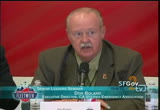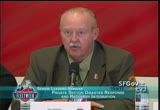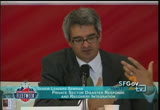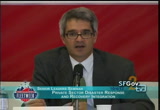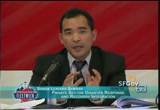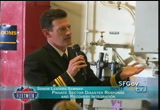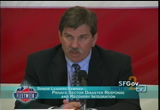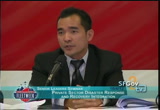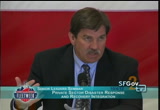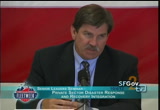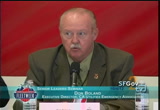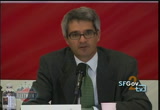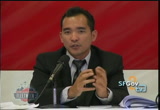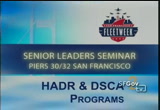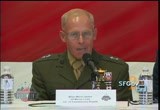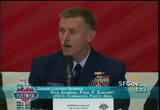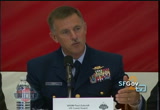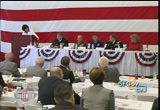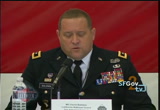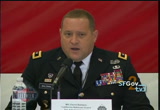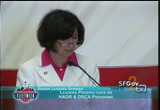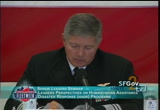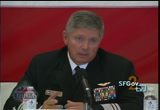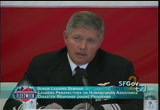tv [untitled] May 4, 2013 3:00am-3:31am PDT
3:00 am
in attitude which is the relationships, distant and local relationships, cross boundaries between the multi disciplines in the utilities. we are able to cross those lines in the counties and step up to state operations so everybody is operating in a common operating picture so everybody understands what's available not only in their jurisdiction, but what kind of resources we can bring to bear, short and long-term, how distant those are, what the qualifications are. we have master resource catalogs designed just like fire scope and cal fire in which we have built strike teams from our utilities, strike teams from water companies. they simply make a call and tell us we need 10, 12, 15, it's our obligation to put that together and get it to them. they are worried about the incident in their jurisdiction which they have to correct. it's our responsibility to reach bond those borders as their extension to bring in the
3:01 am
reserves that they need to maintain that kaupblt newt of operation and then where we function through the state utility operations center and the state operations center to make sure that we have that kind of access and that kind of assistance. we need caltrans, we're going to need chp, we're going to need cal fire, we need dwr, they are invested in restoring their critical infrastructure and it's our responsibility to reach across those lines to get that kind of access to keep that kind of restoration underway. >> thank you. mr. brig. >> in terms of establishing standards for resill yepbs, absolutely, we have done that. again as i mentioned earlier, to get our customers to fund all these capital projects we did up a contract with them. this is what you're getting and this is what you're going to pay for. that had to be well defined as engineers need to know what to do and what to design for.
3:02 am
establishing those standards, what we call levels of service, there's levels of service for threats of terrorism and also the seismic one, which is essentially an 8.0 event on the san andreas fault. we're working with other city departments so they know what to expect from us. it's been an education process. as we started down the road i think there was an expectation all water and sewer was going to be in operation in san francisco after an ert quake. that probably is not going to happen. it's a little bit different having several blocks in your population out of water versus out of electricity or gas or cell phone service. it's a little bit different level of emergency. after an earthquake what we're designing for is to have the high level fire system more or less immediately. there may be
3:03 am
homes, individual service connections, which could be out of water for quite some time and that's where my utility has to interface with other departments to make sure we're getting water to people through humanitarian stations, red cross, mutual aid is a huge part of this with our federal and state partners. but those hand off points after a major event and educating ourselves what we're doing and not doing is a big part of the life line process that naomi is running and it's been very, very helpful. >> thank you. and mr. angelus. >> in terms of standards, similar to pg&e we have established our own internal standards on how resilient our network is. it's two hour quality of service how to design our capacity and also in how we perform, we do these failure tests to make sure the
3:04 am
network can withstand the additional traffic being transferred from one portion to another. we have an earthquake strategy binder which is available aupb lane for our employees that can be accessed. it's available in all of our switches. these are step by step directions what happens when this big one occurs. we also practice this on drills, we have very little drills within the company or within the region to make sure everybody is on the same page when this situation does occur. now, as far as our support with other agencies, you know, our first priority of course when this thing happens is to make sure our network is running. but we also have a number of hotline numbers available for the police department rtion for the local agencies to contact us if they need some adistance from us in case some of their own systems do go down and we have our own infrastructure to support them as well. >> all right, thank you. i think this is an opportunity for us to open it up for
3:05 am
questions and answers. i think we have some folks with microphones right over there, there's a gentleman. >> you talked a lot about network and grid resiliency. how do you guys approach your op center in context of resiliency of operations in terms of something like this ?oo ?a would you mind remeeting that one more time. >> you talked a lot about your grid and the resiliency. it's something we look at all the time if the ship sinks, who is the back up guy in charge. how do you guys approach that stuff.
3:06 am
>> i'll go ahead and cover at least for pg&e. in terms of our emergency centers and understanding what's happening there, we have our primary emergency center here in san francisco. we have on call personnel for both gas and electric and our generation facilities who have responsibilities upwards of about 80 people each and every day, have to be available, available to come in on any notice. we have back-up facilities that can operate out of walnut creek in many cases, we also have a major back-up facility in san ramon where we can duplicate everything that we have in san francisco. in terms of back-up facilities, in terms of our ability to operate if something goes wrong we can bring up our emergency centers and that's for our corporate emergency center. pg&e actually operates over 70,000 square miles. we have 19 division and 55 districts
3:07 am
and every one of those districts has an emergency room or what's often referred to as a storm room and any one of those can open up and handle any other location's facility so we in essence have at least 55 sites we can go to and try to operate from, but certainly with respect to the command structure and how we operate, we want to be in the emergency center for a major event such as an earthquake or major storm, we have 3 facilities that can handle that fairly easily and several that can do duty with a couple days notice. >> mr. boland. >> we are very fortunate, we are fully embedded with the state operations center. should the state decide to close the operations center and relocate, we will follow very closely. we also have 10 virtual centers to operate out of to support the state operation and support the utility industries if in fact
3:08 am
that's called upon. >> mr. brig. >> similar response to the pg&e in terms of back-up centers. the only thing i would add again is the human element. we make sure all the knowledge does not reside in one person. we have a lot of bridges in the area, not all our employees live in san francisco. so it may not be possible to get some of our senior managers here or key employees here quickly within a day, within two days, and it's a constant challenge to make sure we have documentation and broad training for whoever does arrive at the eoc, they are in charge until someone else gets there and that could be a long time. >> thank you. mr. angelus. >> for verizon wireless in northern california we have two separate offices, we have in walnut creek and also folsom near sacramento. we have
3:09 am
another redundancy center in texas. we have it all across our infrastructure and also with our teams. >> thank you. we have one question in the back. >> yes, my question is regarding your ability to bring in repair equipment or crews to make repairs or back-up equipment in case your infrastructure is broken. i know they have that capability but in this area, you know, many roads, bridges would be damaged. do you have your own internal aviation capability or lift capability to bring in those repair equipment and crews or is that something that you would be looking to other organizations to provide that airlift capability? >> start with mr. johnson. >> yeah, we have some limited capability in terms of aircraft and on site helicopters in our outskirting area, but in terms
3:10 am
of a major event in the san francisco bay area, we would be heavily focused on those folks who provide that service to us under contract. we do not have our own helicopters in oakland or san francisco itself, as was already mentioned to, san francisco is very difficult to get to in the case of a major event. it's either going to be getting people in or obviously getting across the bridges and getting material in. while we have the transport ability on the ground we don't have a lot of aircraft capability. most of our facilities wouldn't come in via aircraft anyway. the services we need, it's not typically getting the people, it's getting to the location you need to do the work. while we can drop folks via helicopter, we do that on a pretty regular basis during fires and storms up in the mountains, it's going to be able to get the roads clear and get the bridges open
3:11 am
or get access into the location for which we need to get to. in fact, we suffered tlie that in a lot of the big cities just even during commute times if there's a minor emergency getting tlau and we have a relationship with the city here in san francisco where the fire department and the first responders have reached out to us and will help us get there. i can't say we have that everywhere in our state. certainly in a major event, that would be our concern, our ability to get our work force into the bay area given the type of infrastructure we have here. >> thank you. mr. brig. >> i would add, we don't have aircraft that can lift heavy bull dozers so we would be looking to the state for that. that would be a mutual aid call pretty quick. >> verizon wireless would be the same. the most important thing is for us to get our
3:12 am
resources where they need to work where they can repair or reroute traffic where it needs to be. one of our main offices is located in the south bay. that way we don't have to worry about bridge access to get into the peninsula or san francisco if the situation occurs, but if the situation does occur, we're going it need some help from other agencies to make it happen for us. >> all right, thank you. and we have another question. >> roger that you guys deal with unexpected circumstances all the time, weather circumstances, things that are completely unexpected. i would be really interested in, as a result of your latest hot watches on an vent, whatever that event might have been, what was the big aha thing that you learned from that event? >> well, i don't know if it
3:13 am
was an aha, unfortunately as i mentioned we get the opportunity to practice on a pretty regular basis. i would say the issues that typically come up in a major event really are two-fold. one is communication, communications with everybody, in a major event we will have a thousand to two thousand people out working and understanding where every crew is at and every product on every job is a huge challenge to us. we're concentrating on bringing every customer back on and at the same time not sending a crew to a location we may already have somebody there. it ties directly to the comment i made earlier. getting folks to the location is a real challenge. this happens certainly in storms up in the mountainous areas, facilities are closed, trees are down, bridges are blocked, areas flood. so getting folks to those locations can be very difficult, we end up doing a lot of hand walk ins, a lot of
3:14 am
helicopters in with crews of 30 or 40 folks and communicating with them where there isn't cell coverage even if it did work is a big challenge. the things we focus on the majority of time is how do we improve our communications, what did rerun into this time that we didn't have in the past, how do we get through that and how can we improve getting folks to the facility and making sure we know where everybody is at at all times. >> thank you. mr. boland. >> one of the major challenges that we have incurred all the way from 2003 till now, is credentialing or badging of utility emergency responder personnel trying to gain access into a secure zone that needs their services. as a prepop drapbs of the heavy equipment
3:15 am
sometimes falls under a contractor's jurisdiction and a local officer at a local roadblock does not always know or understand the necessity to get that kind of equipment in there to restore the grid, the water system, for the telecom it is something we are still struggling with and we are working with on a daily basis. >> thank you, mr. brig. >> every exercise i've been involved with, managing information and communication is easily no. 1 or 2 on the list. in the heat of an event, information is flowing in, there's usually no shortage of information rtion it's translating that to something credible that is the challenge. usually 50 percent of that information is wrong and untimely. before a unified command is established and you have various city departments or regional groups that are working together before the unified command has been established, coordinating field
3:16 am
work in 4 counties is usually awkward. until that central message gets pushed down and all the groups are rowing together, the field, when you are dealing with the geegraphy we are dealing with in the bay area, that field coordination is always difficult in the first few hours. >> thank you. mr. angelus. >> verizon wireless, every time we get involved with emergency situations we did a post meeting to analyze what we did and how we can make things better. it also pushes down to the processes and the preparedness and how we can make things better from checking our equipment to our staffing levels and it depends, really, on the situation but we always get something good out of these situations that makes our processes better. >> thank you. i'd like to thank the panel members for taking time out to discuss about lifelines. i want to
3:17 am
point out that all of these organizations are members of the san francisco lifelines council along with many members in the audience, and rest assured we have been working with the fire chief and the police chief with pg&e and the san francisco public utilities commission to make sure we can get them to their emergencies in a timely fashion during rush hour traffic and would like to thank both chiefs who are here today. so thank you. (applause).
3:18 am
>> thank you. and general spiese, if you could talk a little about the relationship and what it means to the marines? >> sure. let me reference mayor lee from this morning. he said what we are starting to do is get beyond conversation and we're getting a feel for the impact of our training and our particular interaction. just this past year alone from the communications, command and control exercise that we did in august, yesterday bringing an air cushioned vehicle ashore on the beach, landing helicopters at lake merced and working between us and the national guard, exercising the evacuation of casualties under the control and observation of
3:19 am
the department of emergency management, and these are things that we can only really understand through exercise, through training and then figure out where the gaps are and what we need to do to smooth those out. i'll also reference lan wilder if i can. she said something that was pretty revealing. prior to yesterday and getting out on the beach and seeing us, her thinking was just to ride out the disaster. now she feels like she's in a position where she can do some strategic thinking and strategic planning, which is really an obligation for all of us in charge. as captain jones said earlier this morning, we do not know what this is going to look like and it's certainly not going to look like what we anticipate. but having us understand how to react and how to interact with each other will give us a basis upon which we can go forward and move hopefully very quickly to salvage what we can in the event of a complex catastrophe. thank you.
3:20 am
>> and admiral zukunft, we heard a little about from captain stow about the different authorities that the coast guard can bring to bear in different situations. but could you talk a little bit about the partnerships and relationship and how that plays across the coast guard mission set? >> well, first i'll talk about my capacity challenges and my area of responsibility covers the rocky mountains to madagascar. the same area of responsibility as admiral lochlear except they have the arctic and antarctic as well. so, obviously with 13,000 people covering that aor, a little over 200 ships, i'm very dependent on partnerships. i work with 71 countries with whom i have 65 bilateral agreements with those entities. but everything really starts at the most local level first. so, it's appropriate to hear from captain stow and the
3:21 am
network of partnerships that she's dealt here in the bay area, but we have this lattice work that goes across my entire pacific region. and then i need to focus on what do i do in the event of a threat right now in dealing with the arctic. what if i have a deep water horizon spill there? because now it affects the nate and i have indigenous tribes of that part of the world. and how do i flow resources there, recognizing the navy doesn't have ice breakers and our nation has one. so, we do a lot of work with canada when we're starting to work on those contingencies. but we look at the national response framework. it was rewritten post katrina. and another key part of partnerships, when i was the federal on scene coordinator during deep water horizon, it's not in the national response framework, but every parish president, every mayor, every governor had a coast guard liaison officer at the oak pride and above level. so, if they didn't like how the response was going, go to my
3:22 am
liaison officer. don't go to anderson cooper and then cause the white house to react to what they're seeing on cnn. so, how do you get in front of that news cycle? and the only way you can do that as tip o'neill said, all things in politics are local and i think we heard from vice admiral nathan that i think all responses are local as well. and, so, we really need to start most importantly at the local level, at those planning levels, because the first shot of any campaign, the plan will change, but the partnerships need to remain constant. >> and, general baldwin, we heard from colonel span owe about now your three hats of authority, your state hat, your federal hat, and now your dual status hat. but if you could talk about the partnerships and relationships and how that plays into your ability to respond under -- wearing each one of those hats? >> sure. first i'll begin with just a little bit more background on the national guard. the national guard is unique amongst the components of the
3:23 am
army and air force in that in addition to our war fighting mission, we have provided support to civil authorities as a core task. that's why we exist as a unique component. in addition, we're a community based force. our soldiers live and work in all the communities and already have a lot of the relationships with the first responders, the public health services, the hospitals and all those entities that would respond in a disaster. the california national guard as mentioned is the largest in the nation under 54 states and territories. we're the largest by far. and we have a broad spectrum of capabilities that range from on the low end manpower where we can deploy troops for either security missions or firefighting hand crew missions all the way up to the high end where we have a wing, we also have space station systems we can employ and support civil authorities at the direction of the governor. we're the experienced national guard force. we do some sort of civil support emergency response
3:24 am
system every three days in california. we support the governor, mainly law enforcement and the fire services here in the state. we tend to do more emergency missions every year than any of the 53 states and territories combined. so, we have quite a bit of experience. with that experience has come a wealth of relationship building that's key to success and any disaster response is being able to work with the inter agency. we're in a unique position because in addition to my federal responsibilities for commanding both the army and the air national guard, i also serve as a member of the governor's cabinet and with that i work on a daily basis with all of the other state level assets and resources, cal ema, cal fire, the highway patrol, health and human services and all the other state entities that would respond to support local authorities. we have a full-time liaison officer embedded in cal ema that works there 7 days a week, 5 days a week to continue to develop and build that relationship. we exercise regularly at all levels of government.
3:25 am
we exercise heavily with the local governments to plan and prepare. and we work very, very closely with defense coordinating officer as we continue to build and work our relationships with north com and the ability to integrate title 10 forces both acting in the reserve into the sole support flight. we have a strong working relationship with the coast guard and we're excited with the team to develop our relationship with the third fleet and marine corps as we mature this tactical man construct. >> thank you. we know that with humanitarian assistance and disaster response that what we learn domestically can be exported internationally and what we learn internationally we hope would be imported to our domestic programs. this morning as we listened to the medical panel and to vice admiral nathan's comments, we heard about some of the skills and expertise in the medical arena that have been learned internationally and are being brought to bear through the exchange both yesterday and
3:26 am
today to the local scene. wondering if the panel has other examples that they could cite on where the benefits have been learned that have been taken, specific skills that have been taken internationally as we look at humantarian assistance, or that you know that you'd like to bring back and bring into the domestic arena. >> just this last summer, we conducted the rim of the pacific exercise 2012. we did it in the state of hawaii and the surrounding operating area. it brought forth 22 nations, roughly 25,000 soldiers, sailors, airmen, marines. but one of the things that we did embedded in this rim pac exercise was a five-day humanitarian assistance disaster relief. we used it as an accreditation not only for some of our adaptive force packages, but more importantly to the state of hawaii to allow them to get an accreditation that they needed for 13 of their
3:27 am
hospitals where we set up on ford island, those familiar with the oahu island geography, we utilized ford island and we had a scenario where there was an earthquake with a resultant tsunami and mass casualties along with the destruction that goes with it to the road infrastructure and communication. and, so, we were able to parlay, if you will, this opportunity to leverage off our international partners. we had seven nations that out of the 22 that actually participated in the hadr, and there were probably also 19 of the 22 that at least observed. but there were 7 of us that actually participated. and we were able to share with each other those things that worked, those things that don't work. it's interesting because one of
3:28 am
the things that we work very hard on was one of the things that the first panel this morning talked about, and that was communication. and language, a common lexicon. so, it was not only a common lexicon, but then a common language that everybody understood when you bring international partners together. we hope we don't have the language barrier for a domestic natural disaster, but nonetheless, there is a language each one of us carries on. we talked about the acronyms each one of us uses. so, we had a real-world -- a real-live exercise that validated some of the things we talk about this morning. but it was extremely beneficial to not only the u.s. navy and marine corps, but to the international community. >> thank you. another hand? >> [inaudible] my experience with the haiti response.
3:29 am
in this casey i was working at the deputy principal committee level and working at the white house. but it was really the first opportunity for this administration to work with a very complex response, and then recognizing for us the supported commander was usaid that normally isn't in the emergency response business. so, it was an educational process of how to move forces and yet support usaid and the role of the country team and port au prince. so, it was very informative there. and to back up when we had the first no fooling hurricane that worked its way up the entire gulf coast, the principal committee calls that were generated during the haiti response were then turned around and then bringing all of the governors into a conference call with the president to make sure that all their needs were being met in the advance of a hurricane arrival. so, we really had all of government, from local all the way up to the white house,
3:30 am
fully included in that response. but the haiti response was certainly informative in bringing all these disparate entities together to provide unity of effort during a response. >> we need general spiese. >> okay, thanks. i would offer a little bit from an institutional perspective at the tactical level in the marine corps. that's an area where we could use some improvement. our forces deployed to the western pacific certainly understand this, and they pass it on among themselves. the forces we deploy from southern california and the east coast that float into theater understand disaster assistance and humantarian response very well. that hasn't quite migrated itself into the institutional arena in terms of forces stationed here in the united states as it would relate to
60 Views
IN COLLECTIONS
SFGTV2: San Francisco Government Television Television Archive
Television Archive  Television Archive News Search Service
Television Archive News Search Service 
Uploaded by TV Archive on

 Live Music Archive
Live Music Archive Librivox Free Audio
Librivox Free Audio Metropolitan Museum
Metropolitan Museum Cleveland Museum of Art
Cleveland Museum of Art Internet Arcade
Internet Arcade Console Living Room
Console Living Room Books to Borrow
Books to Borrow Open Library
Open Library TV News
TV News Understanding 9/11
Understanding 9/11